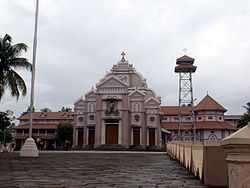Syro-Malabar Catholic Eparchy of Irinjalakuda

The Syro-Malabar Catholic Eparchy of Irinjalakuda is situated in Irinjalakuda city of Thrissur District of Kerala, India. The eparchy was created by Pope Paul VI in his bull Trichurensis Eparchiae of June 22, 1978. Mar James Pazhayattil was the first bishop. He was succeeded by Mar Pauly Kannookadan. The eparchy is a suffragan of the Syro-Malabar Catholic Archeparchy of Thrissur.
History
St Thomas, one of the apostles of Christ, after receiving the Holy Spirit at Pentecost, set about the mission of spreading the gospel of Jesus Christ to the whole world. A review of the life of St Thomas will prove how he fulfilled this great mission in India. According to the tradition, St Thomas came by sea and landed at Kodungalloor (Cranganore) the capital of the then Chera Empire in 52 AD. He baptised families in Kodungalloor and Palayur (Trichur). St Thomas preached the gospel wherever he went, and founded churches. According to Malabar tradition St Thomas founded seven churches, they are in Cranganore, Quilon, Chayal, Kokkamangalam, Niranam, Paravur and Palayur. From there he went to Coromandel and suffered martyrdom near the Little Mount in Tamil Nadu. His body was brought to the town of Mylapore and was buried in a holy shrine. According to "Ramban Songs", St Thomas converted 17,550 people. He ordained priests and consecrated bishops. The Apostle consecrated Kepa, a native, as Bishop of Kodungalloor and as the head of St Thomas Christians and Paul as the Bishop of Mylapore. It is worth mentioning that the Apostle gave his followers a way of worship suited to their clime, culture and customs. Since the 4th century, the Church in India started communication with the East Syrian Church and soon began to introduce liturgical books and share rites. Thus the Indian Church became a member of the Assyrian(Syro-Chaldean) Patriarchate for practical purpose, not for doctrinal reasons.
The head of the Indian Church was called The Metropolitan and Gate of All India, and had jurisdiction over all of the country. When the Chaldean prelates came to India as the spiritual heads of the independent metropolitan provinces under the East Syrian Patriarch, the administration of the Indian Church was done by a native priest with the title Archdeacon of all India or Jathikkukarthavian. The residence of the Metropolitan was first at Kodungallur, then Angamaly etc. Because of the close association of the St Thomas Christians with the East Syrian Church, the Indian Church of St Thomas is classified in history under the Chaldean matrix of rites, as we read in CCEO C.28:2 As Pope Pius XII said "during the centuries that India was cut off from the west and despite many trying vicissitudes, the Christian communities formed by the Apostle conserved intact the legacy he left them, and as soon as the sea passage at the close of the 15th century offered a link with their fellow Christians of the west, the union with them was spontaneous" (AAS, XLV (1953) pp. 96 97). Thus the Syro-Malabar Church, as Pope John Paul II said, "Never severed from the communion with the Church of Rome, in a continuity that the enormous geographic distance has never been able to break". ("Insegnamenti Giovanni Paulo II". III/2. Rome, 1980, p. 513). In the 15th and 16th centuries the Metropolitans of the St Thomas Christians, who were then East Syrians, took Angamaly as their residential see. (cf. Bulls of Pope Julius III dated 10 March 1553 and 4 May 1553 in Giamil, "Genuinae Relationes....." Rome 1902, PP. 17–18-24).
Cathedral
St Thomas Cathedral & Bishop House
External links
| ||||||||||||||